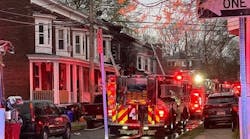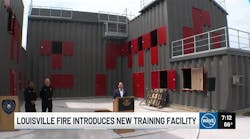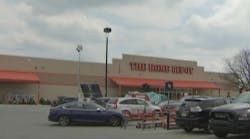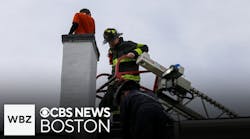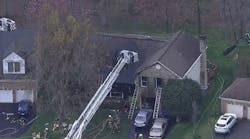Why else would we keep making the same stupid mistakes, generation after generation? Why else would we still be putting human beings on the roofs of truss structures? Why else would we be sending firefighters into abandoned buildings? What other reason is there for having over 1,200 fire companies and departments in a small state like New Jersey?
A number of arguments, and sub-arguments are located within those simple questions. Queries like that might keep us all busy yelling at each other for months, if not years. Anyway, let us now move along. It's time to get on with my history lesson.
In ancient times, people lived huddled together within the confines of a series of walled communities that dotted the landscape of Europe, Africa and Asia. The residents depended on the local ruler to provide security. It was incumbent upon each community to provide for all of its needs.
There was to be no calling for help in time of crisis. This notion prevailed because these folks nurtured, preserved and enhanced the argument that their enemies in the other walled cities would take that call for assistance as a sign of weakness. Therefore, these cities had to prepare for every eventuality. It placed a real strain on their resources.
The local rulers in turn preyed on the ignorance and fear of those who lived within the confines of their closed communities. They extracted a large portion of the income, products or produce produced by these highly dependent people. These rulers also spoke of the people and the rulers in other closed communities as being evil, mean and nasty.
Whether the facts supported the spiel of these village rulers was of no consequence. The people never left their community to see what was going on in other places. People in these societies were governed by a rule of local law that stated, "We've always done it that way." These laws were enforced by a group of men known as the We've Always Done it That Way Warriors. They fell into three classes of member: the boss, the naysayers and the enforcers.
The boss told people what to do. His job was simple. The naysayers went to the citizens when they heard of a progressive idea. They sought to discourage any attempt at creating new ideas and procedures. Regardless of the idea, they would scoff and suggest that if it were such a great idea, the ruler would have thought of it.
Enforcers had a simpler job. When the ruler said to break a few heads, they sallied forth into the community and whacked the offending community residents over the head with a maul. Their mission was to discourage the development of independent thinking. It wouldn't do for people to have ideas that were at a divergence from what the ruler wanted.
I would think it possible that you may have met examples of these people within your organization. They still exist. And their functions and rolls within society remain the same. Give orders, discourage thought, and keep the folks within the village under control and ignorant of events in the outside world.
Civilization stagnated. Fear ran rampant. Advances in every field were stymied by the enforcement efforts of the We've Always Done it That Way Warriors. So it was for many centuries.
Luckily for us, civilization has advanced to a great degree. We no longer live in isolated little enclaves, protected by our local warrior leaders. Right?
Wait a minute. Does that historical story suddenly seem strikingly familiar to you? I know that it brought several ugly flashes of reality to the video monitor located within my mind's eye. I am afraid that this historical vignette could describe the manner in which a great many of the fire kingdoms have arisen around the world. It also has the potential for explaining many of our problems within the fire service.
Far too many fire departments operate as though nothing else in the world had an impact upon them. I can recall a major New Jersey city that refused to send cover units to neighboring cities. I can recall battling with my boss over the issue of mutual aid and automatic aid. In a densely populated urban area, municipal borders should not be used as the walls of that medieval walled city I spoke of earlier. If a fire station in a neighboring city is closer to our customer, the citizen who lives in our city, we owe it to our customer to give them the best service possible.
Recollections of the boss telling me to forget about mutual and automatic aid weigh heavy on my heart. He informed me on more than one occasion that we were being paid to protect our city, and nowhere else. I suggested that this was somewhat shortsighted. The multi-directional sharing of resources and services strengthens the position of every player in the equation.
If we could send two pumpers to a fire in the next town, and the fire department in the next town sent two pumpers, then the customers at that location would gain the benefit of four fire vehicles, at a cost of two to their town, and two to our city. The same result holds true if those two units from the next town respond into our city.
We all grow in strength when we share resources in a timely fashion. In today's cost containment conscious world it is actions, such as I am suggesting, that can save money for all parties concerned. As you might imagine, I was met by a whole chorus of naysayers from the We've Never Done it That Way Warriors. These are the people who also help the bosses enforce the "we've always done it that way" laws within society.
Many of my fellow firefighters from around New Jersey have let me know time and again that they disagree with my position. Rather than building bridges, they would choose to erect walls. As residents of their walled city, they do not want help from our walled city or any other adjoining walled city. They chant on and on about wanting to expand their staffing, equipment and apparatus levels, rather than sharing resources across the board. They want, they want and they want, but their towns do not have the ability to pay for their wants and desires. So we go on operating with a series of marginally equipped and staffed fire departments.
Their focus is decidedly inward. Rather than create a strong regional team, whose members pass from town to town over the bridges of good will and teamwork, they choose to hunker down behind the comfortable walls of their understaffed and under equipped forts.
I would suggest that the effective, modern leader should be concerned with creating partnerships. The purpose of any partnership in the fire and emergency service world is fairly simple. Agencies come together in a common effort to improve service over a regional area. Responses occur in line with agreements that favor all parties to the accord. The weaknesses of one agency are countered by inserting the strengths of the other parties to the agreement.
We have done this in Howell Township, NJ, for quite some time. It became obvious as far back at the late 1980s that staffing during the daytime was becoming a problem. After many years of on-again, off-again aid agreements, the voice of reason began to be heard. Rather than letting the personalities of the people in command raise and lower the walls of the competing walled cities, some really forward-thinking people began to build bridges.
The fire chiefs of the five fire departments in the township entered into negotiations. After a protracted series of negotiations, representatives from the chiefs met with the township police department, which is our dispatch agency. An agreement was hammered out that called for a series of automatic aid responses between 6 A.M. and 6 P.M.
Another piece of our regional puzzle comes from the inclusion of the Farmingdale Fire Department in the operational response picture. Our fire department in Adelphia created another agreement whereby Farmingdale responds to many parts of our fire district on a 24/7 basis. It has been this way for a long time. While each of our departments may experience periodic staffing shortfalls during the day, our agreements allow us to present a stronger, more united front in the effort to protect the citizens of our community.
In early 2002, a new set of bridges was built in Howell Township. All fire agencies now operate on a designated set of radio frequencies. Procedures have been developed that allow for multi-agencies operation to be placed on separate operational channels. Fire, police and EMS personnel in our community can now conduct interactive emergency operations across a range of operational radio channels. In addition, there are township-wide rapid intervention team guidelines. The training, procedures and systems are consistent across the board for all five fire departments.
No part of this plan could have been succeeded if the players and leaders in the individual agencies had remained hunkered down behind the walls of their fire stations/walled cities. This is but one small example of the concept of bridge building among modern leaders.
Some of the real bridge builders among us are fire chiefs. They are people like Chief Bill Peterson of Plano, TX. As past president of the American Branch of the Institute of Fire Engineers of Great Britain, Bill Peterson has worked to build bridges among the various players in the world of fire protection, around the globe.
The same holds true for my friend Chief Alan Brunacini of Phoenix. He has served in a variety of positions, up to that of chairman of the National Fire Protection Association's Board of Directors. During his time, he has worked with people from just about every discipline in the public and private sectors. We have been drawn together as a service because of his efforts.
Be warned. For every bridge builder that we meet, there are literally scores of people at work to undermine their efforts. The forces of complacency are everywhere. These folks are working with equal fervor to keep things just they way they are. These are the people who would have us using booster lines to fight fire and 21/2-inch hoselines to supply our equipment. These are the people who laugh at turnout trousers, self-contained breathing apparatus, Nomex coats and 1,000-gallon booster tanks. These are the people who will proudly state that no one has fires like Lower South Bo Hunk Fire District Number 99. They will then go on to swear upon a stack of locally printed fire bibles that everything is unique and special within their operational area. Folks like this will then go on to state that they solved all of their problems in 1963. They can see no reason to rock their boat of life with newfangled gizmos, gadgets and ideas.
I want to suggest that the day is long past when any of us could go it alone. Sept. 11, 2001, showed us that even the biggest of cities could face challenges that were beyond its ability to handle. People like the folks from Bo Hunk need to come into the 21st century, or at least the late 20th century. These reprobates need to understand that building a bridge involves a completely different process than walking the plank.
I would urge you to become a modern leader. I would urge you to become a builder of great bridges. To remain static is to risk death. As always, the choice remains yours.
Harry R. Carter, Ph.D., MIFireE, is a Firehouse® contributing editor. A municipal fire protection consultant based in Adelphia, NJ, he is a former president of the International Society of Fire Service Instructors (ISFSI). Dr. Carter is an associate professor at Mercer County Community College and a past chief and active life member of the Adelphia Fire Company. A fire commissioner for Howell Township District 2, he retired from the Newark, NJ, Fire Department in 1999 as a battalion commander. He also served as chief of training and commander of the Hazardous Materials Response Team. Dr. Carter is a Member of the Institution of Fire Engineers of Great Britain (MIFireE). You can contact him through his website at [email protected].